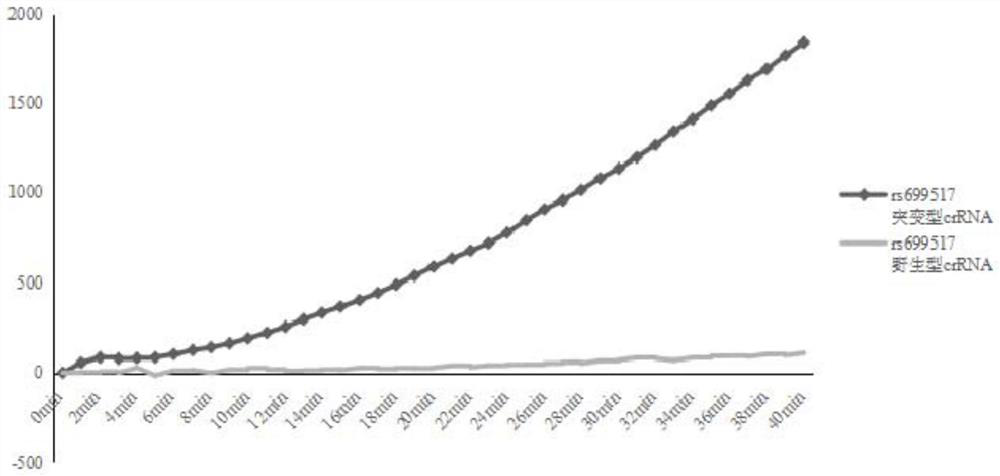Kit for detecting cerebral apoplexy related TYMS gene based on CRISPR
A detection kit and gene technology, which is applied in the determination/inspection of microorganisms, DNA/RNA fragments, biochemical equipment and methods, etc., can solve the problems of inability to detect gene mutations in clinical samples on a large scale, long detection time, low accuracy, etc. problem, to achieve the effect of high sensitivity, high accuracy and high conversion efficiency
- Summary
- Abstract
- Description
- Claims
- Application Information
AI Technical Summary
Problems solved by technology
Method used
Image
Examples
Embodiment 1
[0048] Embodiment 1 Design and acquisition of crRNA targeting gene mutation site
[0049] (1) Design principles of crRNA targeting gene mutation sites
[0050] Since the CRISPR-Cas12a system is a novel targeted DNA gene editing system, in which Cas12a combines with crRNA to form a monitoring complex, the guide region of crRNA recognizes the target DNA with a complementary sequence, and Cas12a degrades the target DNA strand. Wherein the crRNA design requirement: crRNA includes protein anchor sequence and guide sequence, sequence format is: 5`-anchor sequence combined with Cas12a protein-crRNA guide sequence-3`, protein anchor sequence needs to be determined according to Cas12a protein , so that it can match and bind to the selected Cas12a protein; the guide sequence matches the fragment in the targeted DNA.
[0051] (2) Selection of crDNA sequence
[0052] The cas12a protein selected in this embodiment is FnCas12a, so the anchor sequence selected to bind to the Cas12a protein i...
Embodiment 2
[0062] Example 2 Detection kit and detection method for stroke-related TYMS gene mutation sites
[0063] 1. The composition of the kit for the detection of TYMS gene and stroke-related mutation sites
[0064] 1) 2 mutant crRNAs (obtained as shown in Example 1), the sequences of which are shown in SEQ ID NO.3-4;
[0065] Or 2 mutant crDNAs (when the kit is crDNA, the user needs to first generate RNA from the crDNA fragments under the action of T7 RNA polymerase, recover and purify the crRNA, see Example 1 for details), its sequence is as SEQ ID NO .1 ~ 2 shown.
[0066] 2) A specific fluorescent probe, in this embodiment, the fluorescent probe is specifically any one of Table 2:
[0067] Table 2 Fluorescent probe sequences
[0068]
[0069]
[0070] 3) cas12a protein, in this embodiment, Fncas12a is used.
[0071] 4) Enzyme-free water and DNase inhibitors.
[0072] 5) A primer pair for specifically amplifying rs699517 and rs2790 polymorphic sites on the TYMS gene, th...
Embodiment 3
[0084] Example 3 Detection of TYMS Gene Mutation Sites Related to Stroke
[0085] 1) Take 10-50 ng of sample DNA to be tested and add it to the amplification system shown in Table 3, wherein the primers are corresponding amplification primer pairs shown in SEQ ID NO.5-8.
[0086] Table 3 PCR amplification system
[0087]
[0088]
[0089] 2) Add the obtained amplification product to the detection mixture (the mixture contains 100-200 nM purified FnCas12a, 100-200 nM crRNA, 1-5 μL synthetic fluorescent probe, 2 μL DNase inhibitor and enzyme-free water) , incubate at 37°C for 0.5-1h in detection buffer (NEBuffer 2.1), the detection system is shown in Table 4:
[0090] Table 4 detection system
[0091]
[0092] After incubating the detection system, use a fluorescence detector to continuously measure the fluorescence value, and at the same time use wild-type crRNA to set up a negative control group, and judge whether there are corresponding molecular markers related to...
PUM
 Login to View More
Login to View More Abstract
Description
Claims
Application Information
 Login to View More
Login to View More - R&D
- Intellectual Property
- Life Sciences
- Materials
- Tech Scout
- Unparalleled Data Quality
- Higher Quality Content
- 60% Fewer Hallucinations
Browse by: Latest US Patents, China's latest patents, Technical Efficacy Thesaurus, Application Domain, Technology Topic, Popular Technical Reports.
© 2025 PatSnap. All rights reserved.Legal|Privacy policy|Modern Slavery Act Transparency Statement|Sitemap|About US| Contact US: help@patsnap.com



